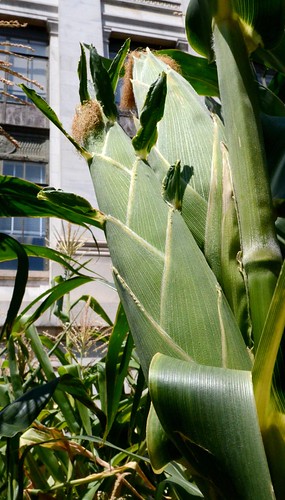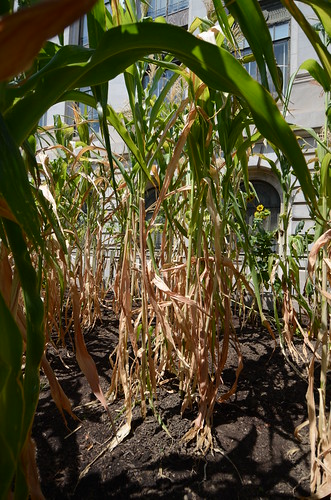A day in the life of a U.S. Department of Agriculture photojournalist is never the same. This one was no exception.
It started out testing a new memory card that transmits photos from a digital camera to our Flickr social media gallery (www.USDA.gov and click the Flickr link). After making the card work in the office , a field test was in order.

The nearest field was the Native American Garden, one of the two People's Garden fields just outside Whitten Building. My task was simple enough, take some pretty photos of corn and see if technology does it's magic. As soon as I take the first photo of what it thought were two big fat healthy ears of corn I hear voices behind me on the sidewalk, "Look at that, they're past their harvest."

So, me being a "city-boy" had to turnaround and see who was making these comments about these "perfect" ears of corn. Turns out a mother and young teenaged son were walking from one tourist site to another, and stopped to looking up at the rows of 9-foot stalks. Their voices were confident and seemed to speak from experience as they continued, "They waited too long." The young man was still nearby, while the mom continued past the garden watching our conversation. When asked how they made such deft evaluation, he easily pointed out the brown lower portions of the stalk and the yellowing upper half.

A closer look at other ears of corn, revealed corncobs kernels that were picked away by birds. What kernels that remained, were simply dried out in the sun, because the husk was picked away. In the next moment, the boy was gone, before I could get names or a photo.
What he didn't know and I had forgotten, was that the Three Sisters crop, in this demonstration garden, was keeping with Native American tradition. The type of corn planted is Dent Corn or field corn. Not the kind most of us are used to seeing on a dinner plate.
In fact, Dent Corn must be ground or further processed to be usable. And, unlike its sister crops of beans and squash, it is not suitable for donation to local food banks. Please see photos and info from the day the plants were planted on our Flickr site.
So, corn stalks are not all the same. Just as, their harvest times are not all the same. With this crop, birds get a free meal, the stalks will become holiday decorations; and visiting groups to passers-by get to see living American heritage growing before them.
All in all, the young (hopefully) future farmer was inspiring. I was left recalling the voice of Agriculture Secretary Tom Vilsack, as he often speaks about the value the next generation of farmers, who are they; what will be their motivation; where will they get help if needed in a world whose population is increasing, and the number of farmers are decreasing. Today, I met one young man that might be part of the answer.
